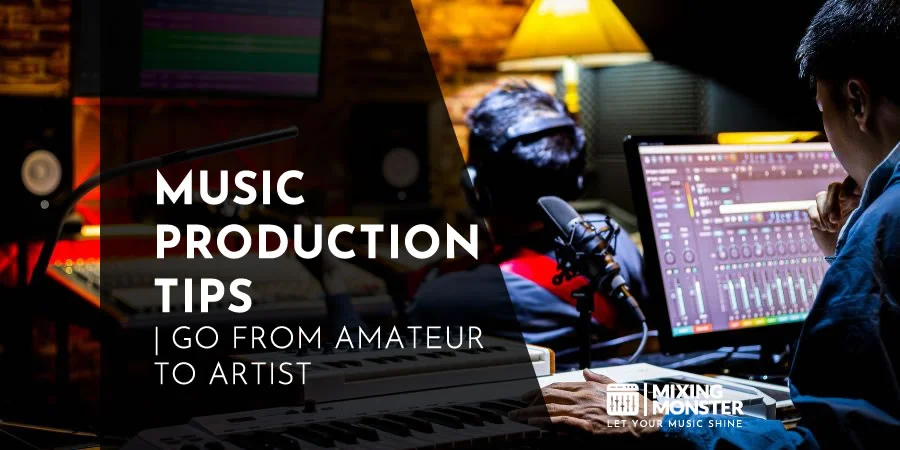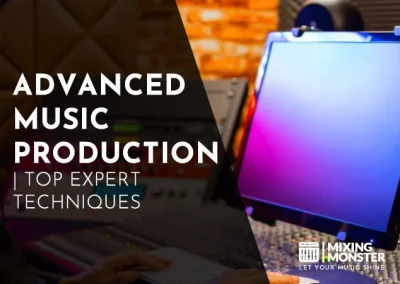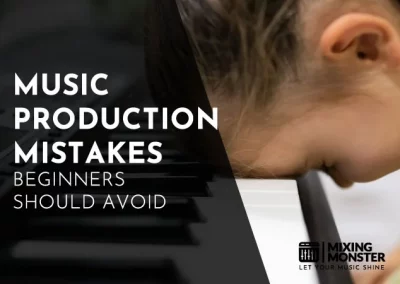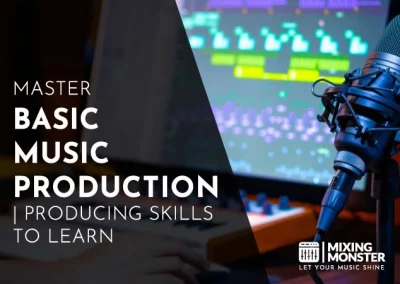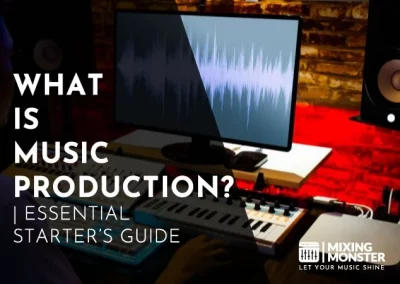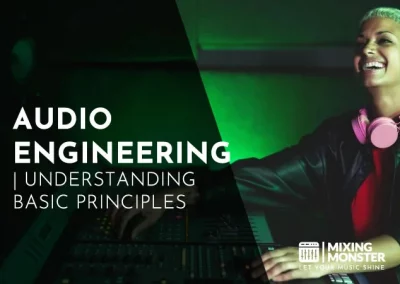Home > Blog > Music > Music Production
Disclosure: Some of the links below are affiliate links, meaning that at no additional cost to you, we will receive a commission if you click through and make a purchase. Read our full affiliate disclosure here.
Whether you’re a budding producer or an experienced musician looking to enhance your studio skills, grasping practical music production tips is essential. A comprehensive understanding of this craft can transform raw musical concepts into polished, professional-sounding tracks.
Music production encompasses everything from the foundational knowledge of sound and rhythm to the art of audio mixing and mastering. It’s a multifaceted domain, requiring technical skills to maneuver digital audio workstations (DAWs) and an artistic touch to infuse life into every composition. By mastering various production techniques and learning to manipulate tools and plugins efficiently, you pave the way to creating captivating music that resonates with your audience.
Your adventure in music production is about to take a significant leap. As you dive deeper into the subsequent sections, you’ll acquire practical songwriting techniques, learn valuable recording tips, and understand the essentials of mixing and mastering. You’ll optimize your workflow with each step, enhancing creativity and output.
KEY TAKEAWAYS:
- Music production is a skillful craft combining technical prowess and creative insight.
- Proficiency in production techniques is crucial for transforming ideas into professional tracks.
- Further exploration offers practical strategies and insights for advancing your music production journey.
Table Of Contents
1. Overview Of Music Production Tips
2. Songwriting Techniques
3. Recording Tips
4. Editing Strategies
5. Mixing Essentials
6. Mastering Final Touches
7. Advanced Music Production Techniques
8. Music Production Workflow Optimization
9. Music Production Creativity And Inspiration
10. The Business Of Music Production
11. Wrapping Up Music Production Tips
12. FAQ

1. Overview Of Music Production Tips
Music production requires a firm grasp of a few foundational elements. From mastering the tools of the trade, such as your digital audio workstation (DAW), to establishing a conducive environment for creativity, each aspect will collectively form the bedrock of your music production journey.
#1 Grasp The Fundamentals Of Your DAW
Your DAW is the epicenter of music creation. It’s critical to become adept with its functions, from recording to mixing. Investing time in learning about your digital audio workstation is a step that pays dividends in quality and creativity. Look into tutorials or courses that cater to your chosen DAW, like Ableton Live, Logic Pro, or any other platform.
#2 Set Up An Ergonomic Production Workspace
An ergonomic workspace will ensure you can work for hours without discomfort. Position your computer, monitors, MIDI controllers, and other equipment within easy reach. The area should be clutter-free, have good lighting, and offer a comfortable chair that promotes a good posture, reducing the strain on your body during long sessions.
#3 Learn Basic Music Theory
Understanding the basics of music theory provides a framework for your creativity. Grasp concepts like scales, chords, and melody to enhance the musicality of your productions. Even a fundamental knowledge of theory can vastly improve your work’s coherence and sonic appeal.
#4 Develop An Efficient Workflow
A streamlined workflow saves time and boosts productivity. Create templates within your DAW for different projects, organize your sample library for easy access, and learn keyboard shortcuts to expedite production. Regularly update and back up your work to avoid data loss.
#5 Organize Your Sample Library
Keeping your samples and plugins well-ordered is essential. Categorize them by type, genre, or any system that helps you quickly locate the right sounds. Regularly curate your library, removing rarely used samples to keep your selection fresh and relevant.
You will establish a solid foundation in music production by focusing on these critical areas. Continually learning and adaptation are part of the process as technologies and techniques evolve.
2. Songwriting Techniques
Mastering various songwriting techniques can elevate your music production by infusing creativity and emotion into your work. This section covers practical methods to develop catchy melodies, harmonious chord progressions, and effective workflows for prolific songwriting.
#6 Start With A Strong Melody Or Hook
A memorable melody or hook is often the anchor of a song. To create strong melodies, start with a simple motif and build complexity as needed. Remember, the hook is not just a musical idea but can also be a lyrical phrase that captures the essence of the song’s emotion.
#7 Experiment With Chord Progressions
Chord progressions are the backbone of song structure. They lay the framework upon which your melody will dance. Don’t hesitate to examine different chord progressions; sometimes, a slight alteration can bring a fresh perspective to your songwriting.
#8 Use Reference Tracks For Inspiration
Listening to music by others can spark your creativity. Use reference tracks to understand how other songwriters build their melodies and structure their songs. Analyzing these can lead to new insights and techniques you can apply in your music production.
#9 Collaborate With Other Musicians
Working with other artists can blend different experiences, skills, and styles, leading to innovative songwriting. Collaboration often leads to unexpected twists and turns that can bring a unique touch to your lyrics and melodies.
#10 Write Music Regularly To Hone Your Skills
Consistent practice is key to improving your songwriting abilities. Make it a habit to write music regularly, daily or weekly, to develop your craft. Each new piece of music is an opportunity to refine your skills and discover new techniques.
By exploring these songwriting techniques, you’ll become adept at expressing your vision through music, crafting resonating melodies, and producing captivating songs.
3. Recording Tips
High-quality music requires more than just hitting the ‘record’ button; it calls for the right equipment, techniques, and practices. This section will guide you through essential recording tips to ensure your tracks are captured cleanly and effectively.
#11 Invest In Quality Microphones
Investing in solid condenser and durable, dynamic microphones is crucial for excellent sound capture. Condenser mics are typically better for capturing the nuances of vocals and acoustic instruments due to their sensitivity and wide frequency response.
Meanwhile, dynamic mics are more robust, making them ideal for capturing drums and guitar amps’ loud and energetic sounds.
#12 Explore Different Mic Placement Techniques
Mic placement can drastically impact the sound quality. Experiment with proximity and angle towards the sound source. For instance, positioning the mic slightly off-center with vocals can reduce plosives.
Moving the mic closer for guitar cabinets can emphasize the bass frequencies, while a distance captures more of the room’s ambiance. Drum mics require a precise placement to balance the kit’s diverse sounds.
#13 Record Multiple Takes For Flexibility
Recording several takes of the same part provides you with options during mixing. Aim to capture a few clean takes, even if the first sounds perfect. This practice allows you to choose from different performances or to compile a ‘comp’ track, combining the best segments of multiple takes for a flawless performance.
#14 Capture Clean Signals With Proper Gain Staging
Gain staging is critical for a clean signal without distortion. Make sure your audio interface levels are correctly set to avoid clipping. While recording, watch the meters; aim to peak around -18dBFS to -6dBFS on your audio interface, ensuring enough headroom for the mixing stage.
#15 Utilize A Metronome For Tighter Performances
A metronome can significantly tighten up your playing, particularly during tracking. It ensures that all recorded instruments like guitar, drums, and even vocals maintain consistent timing, which is crucial for a coherent performance. It’s constructive when you’re layering multiple takes or instruments.
4. Editing Strategies
Editing is a crucial phase in music production that refines recorded material into a polished final product. Your focus on precision, smooth transitions, pitch accuracy, authenticity, and clarity will result in a more professional sound.
#16 Trim And Align Tracks For Precision
Ensure that each track starts and ends exactly where it should by trimming silence at the beginning and ending of recordings. Align your tracks to the correct beat and rhythm to maintain a tight and cohesive arrangement, which is essential for maintaining the groove and flow of your song.
#17 Use Crossfades To Smooth Transitions
Apply crossfades between clips to eliminate clicks and pops and create seamless transitions. Short crossfades can prevent unwanted noise during cuts, especially in vocal and string tracks where sustain is critical.
#18 Implement Pitch Correction Tastefully
Utilize pitch correction tools to fine-tune the intonation of vocal tracks. However, do it sparingly and subtly to maintain the natural qualities of the performance. Overuse can result in an artificial sound that detracts from the song’s emotional impact.
#19 Edit MIDI For Humanized Performances
MIDI editing allows you to correct timing and velocity variations, but you also want to avoid over-quantization. Strive for a balanced MIDI arrangement where the performance sounds natural and human, with slight rhythm and dynamic variations that give life to your music.
#20 Clean Up Background Noise And Artifacts
Remove unwanted background noise and artifacts to enhance clarity. Use noise gates, spectral editing, and other restoration tools to clean up the tracks without affecting the desired audio. Maintaining high-quality recordings is imperative for a professional-sounding mix.

5. Mixing Essentials
In mixing music, the goal is to achieve clarity and balance, ensuring each element sits nicely in the mix. Use tools like EQ, compression, and spatial effects to enhance your mix.
#21 Balance Levels With Faders Before EQ
Start your mix by adjusting the fader levels for each track to achieve a balanced mix before applying EQ. This foundational step ensures that every element can be heard and sets the stage for a more detailed mix. Remember, your studio monitors or speakers act as a reference, so trust your ears and aim for an even distribution of sound.
#22 Pan Elements For A Wider Stereo Image
Panning helps in achieving a wider stereo image and prevents tracks from clashing. Distribute elements across the stereo field but avoid hard panning in most cases. Panning aims to mimic a natural listening environment, where sounds have dimension and distinct left-right placement.
#23 Apply EQ To Carve Out Space For Each Element
Use EQ to assign a ‘space’ in the frequency spectrum for each instrument or vocal. For instance, cut low frequencies from non-bass elements to leave room for the bass and kick drum. Boost or cut specific frequencies to enhance the presence or reduce muddiness, ensuring that no two elements compete for the same frequency range.
#24 Use Compression To Control Dynamics
Compression is critical in managing the dynamics of your mix. It levels out the audio performance by reducing the volume of loud sounds or amplifying quieter sounds. Apply compression judiciously to keep the mix transparent without over-compressing and losing the natural character of the instruments.
#25 Create Depth With Reverb And Delay
Reverb and delay are powerful tools for adding depth and space. By sending signals to a reverb or delay bus, you can control the ambiance of each element. Short reverb can add body to dry signs, while longer settings can place elements further back in the mix.
6. Mastering Final Touches
Mastering is your final chance to enhance and polish your mix to achieve a professional sound. This stage ensures your music stands up to commercial releases and sounds its best across all playback systems. Here’s how to put the final touches on your music in the mastering phase.
#26 Understand The Goal Of Mastering
Mastering is more than just making your track louder; it’s about achieving balance and consistency in your music. Your aim should be to ensure cohesiveness across an album and prepare tracks for distribution, with attention to audio mastering standards.
#27 Use A High-Quality Limiter For Loudness
A limiter is crucial to prevent clipping and manage loudness. Aim for a transparent sound that doesn’t introduce distortion when setting your limiter. Your peaks should lightly kiss the limiter to boost volume while retaining dynamic range.
#28 Enhance Stereo Width Judiciously
To create an immersive listening experience, consider the stereo field. However, use stereo enhancement tools with care to avoid phase issues that can cause your mix to lose impact on mono-playback systems. Subtle width adjustments can yield a more open-sounding mix without compromising the professional sound quality.
#29 Reference Your Master On Multiple Systems
Test your master on various audio systems to check for consistency in sound. Listen on headphones, car speakers, high-end monitors, and laptop speakers. This variety of references ensures your master translates well across different listening environments, making adjustments based on these tests for a more universally appealing sound.
#30 Keep Headroom For Streaming Platforms
Modern streaming platforms often use normalization, which can impact the perceived loudness of your music. By leaving appropriate headroom, you maintain a level of dynamics and avoid the risk of further compression by streaming services. Aim for the platform’s suggested standards without compromising your track’s dynamics and clarity.
7. Advanced Music Production Techniques
Enhancing your music production involves mastering various advanced techniques to take your sound to a new level. This section will explore sophisticated methods such as intricate sound design, dynamic compression, and creative automation to broaden your sonic palette and add depth to your tracks.
#31 Explore Sound Design With Synthesis
Synthesis is key for crafting unique sounds that set your music apart. By delving into digital synths and synthesizers, you can manipulate waveforms and apply filters to generate fresh, innovative sounds. For instance, you can modulate frequencies using an oscillator on a digital synth to create interesting textures that will enrich your sound landscape.
#32 Experiment With Sidechain Compression
Sidechain compression is not just for achieving that signature “pumping” effect. It’s a versatile tool that can carve space in your mix by dynamically reducing the volume of one track to make room for another. Example: Apply sidechain compression to your bass track keyed to the kick drum; this technique ensures that every kick hit cuts through the mix sharply.
#33 Implement Automation For Dynamic Changes
Automation allows you to make precise adjustments over time within your track. It’s crucial for creating tension and release through gradual changes in parameters like volume, pitch, and effects. You could automate a filter sweep on a loop to evolve the texture across the progression of your track, making for a more engaging listening experience.
#34 Dive Into Multiband Processing
With multiband processing, you can apply effects to isolated frequency ranges. For example, you could apply compression only to the mids of a synth pad, leaving the highs and lows untouched for clarity and fullness. This selective processing grants you meticulous control over the sound design of each element in your mix.
#35 Use Parallel Processing For Added Depth
Parallel processing involves blending the processed signal with the original, unprocessed signal. This method adds depth and character without overtaking the core sound. One technique is to mix a heavily compressed version of your vocal track with the original to add consistent intensity throughout your song.
Remember, experimenting with these techniques will expand your sound palette and enable you to produce tracks with a professional edge.
8. Music Production Workflow Optimization
Optimizing your workflow in music production is pivotal to working smarter, not harder. This involves developing a systematic approach that can save time, streamline collaboration, and ensure the timely completion of your music projects.
#36 Develop Templates To Speed Up Your Process
Start by creating templates that encapsulate your unique setup and preferences. These can include your standard EQ settings, preferred signal chains, and commonly used effects. Templates cut down the time you spend setting up, allowing you to jump straight into the creative process.
#37 Use Keyboard Shortcuts To Work Efficiently
Learning and customizing keyboard shortcuts can drastically improve your efficiency. Shortcuts allow you to execute commands quickly without navigating through menus. Spend time committing these to memory to speed up editing, recording, and mixing tasks.
#38 Back-Up Your Projects Regularly
Protect your work through regular back-ups. Establish a consistent back-up routine for multiple locations, such as external hard drives and cloud services. This ensures that your projects remain safe and recoverable during technical failure.
#39 Learn To Bounce Stems For Collaboration
When working with others, know how to bounce stems effectively. This involves exporting individual tracks from your project, which can be easily shared and incorporated into other producers’ work. Stems are crucial for remote collaboration and remixing.
#40 Set Goals And Deadlines To Complete Projects
Setting clear goals and deadlines is essential for project completion. Outline the steps needed to reach your goals with specific timelines. A well-planned schedule keeps you focused and can help push projects across the finish line.
9. Music Production Creativity And Inspiration
Maintaining creativity and inspiration is essential for crafting original and compelling music in music production. The following strategies can help keep your creative juices flowing and your production process fresh and exciting.
#41 Take Breaks To Avoid Burnout
It’s crucial to understand when to step away from your workstation to refresh your mind. Regular breaks can prevent burnout and often lead to sudden bursts of inspiration when you return. Even a short walk or a change of scenery can re-energize your creativity.
#42 Seek Out New Music For Fresh Ideas
Exposing yourself to new music, especially from different sub-genres, can offer new ideas for your tracks. Whether it’s a rhythm pattern, a unique sound, or a harmonization technique, you can incorporate elements from these discoveries into your music production process.
#43 Repurpose Old Projects To Spark Creativity
Review your previous work and find unfinished tracks or elements you can repurpose. Revisiting older sessions might reveal hidden gems that can be transformed into something new and exciting.
#44 Set Up A Portable Rig For On-The-Go Production
A portable setup on your laptop lets you capture moments of inspiration wherever they strike. You can leverage different environments to enhance your creative output by not limiting yourself to a traditional studio space.
#45 Challenge Yourself With Genre Switching
Dive into a different genre than you’re used to; this can significantly broaden your musical horizons. Genre switching fosters adaptability and can teach you new techniques that can be applied to your primary genre, enriching your sound palette.
10. The Business Of Music Production
Engaging effectively in the music production business necessitates a deep understanding of your rights and how to leverage them for financial gain. Building a robust network within the industry is equally essential, as is establishing a commanding online presence. Let’s explore these crucial aspects that will elevate your music career to the next professional level.
#46 Understand Basic Music Rights And Royalties
As a music producer, you must familiarize yourself with the types of music rights, including mechanical, synchronization, and performance rights. Each type dictates how your music can be used and the royalties you’re entitled to receive from those usages.
Platforms such as Producersphere emphasize the importance of understanding the legal facets of music production to safeguard your works.
- Mechanical Rights:
Earn royalties when your music is copied and distributed. - Performance Rights:
Collect fees when your music is played publicly.
#47 Network With Industry Professionals
Strategic networking lets you connect with key players, from music labels to fellow producers and artists. Attending industry events and utilizing platforms dedicated to the music business can be instrumental. Such connections can lead to collaborations and opportunities available outside traditional channels.
- LinkedIn:
Connect with industry veterans and up-and-coming talents. - Local Events:
Participate in music festivals and workshops.
#48 Build An Online Presence
Your brand in the digital world is the modern-day portfolio. Platforms like LANDR Blog highlight the significance of being visible and active across various online channels. Cultivate your brand through:
- Social Media:
Platforms like Instagram and Twitter are great for showcasing your work and engaging with your audience. - Your Official Website:
A hub for everything about your music, from your portfolio to upcoming projects.
#49 Consider Self-Publishing Your Music
Self-publishing provides control over your music distribution and the lion’s share of your revenue. Tools for self-publishing your music have democratized the industry, making it possible to release music without a traditional record label.
- Digital Audio Workstations (DAWs):
Record and produce your music independently. - Online Distributors:
Platforms like DistroKid or Tunecore can distribute your music to major streaming services.
11. Wrapping Up Music Production Tips
You’ve traversed through songwriting, mixing, and mastering in the labyrinth of music production. Your journey has been filled with recording sessions, meticulous editing, and selecting the right equipment. As you conclude your music production process, consolidate critical considerations to ensure your tracks stand out.
Workflow:
- Develop a systematic approach to your sessions.
- Streamline your process by using templates.
- Regularly back up your work to avoid data loss.
Songwriting:
- Aim for coherence; every element should serve the song.
- Iterate your drafts; refining over time enhances quality.
Recording:
- Experiment with microphone placements for optimal sound.
- Make sure your recording space is acoustically treated.
Editing:
- Trim and align takes precisely for a polished sound.
- Use automation to shift volumes and effects dynamically.
Mixing And Mastering:
- Keep levels balanced; watch for clipping.
- Use EQ to eliminate frequency conflicts.
- Master with a gentle touch to retain dynamic range.
Equipment:
- Familiarize yourself with the gear you own.
- Remember, skill trumps expensive hardware.
Production Tips:
- Seek constructive feedback from trusted peers.
- Continuously learn and adapt to new techniques.
Your music production is a reflection of your creativity and technical prowess. Always be conscious of your methods and their impact on your final piece.
Remember, music production is an evolving art—stay curious and keep honing your craft.
Happy producing!
12. FAQ
1) What essential software tools are recommended for beginners in music production?
For beginners, a reliable Digital Audio Workstation (DAW) is indispensable. Options like Apple’s Logic Pro cater to Mac users, while FL Studio and Ableton Live are popular cross-platform choices. They provide the necessary functionality to record, edit, and produce audio tracks.
2) Which techniques can significantly improve my music production skills?
Learning the art of mixing and mastering can elevate the quality of your music. Focusing on techniques like equalization, compression, and proper gain staging can significantly enhance the clarity and balance of your production.
3) What are the key stages in the music production process?
The music production typically consists of composing, arranging, tracking, editing, mixing, and mastering. Each stage plays a crucial role, from creativity in composing to the final polishing in mastering.
4) Can you suggest practical ways to hone music production skills for advanced producers?
For advanced producers, diving into advanced sound design techniques, exploring new genres, and collaborating with other artists can expand your creative repertoire. Continuous learning and adapting to new technologies also foster growth.
5) What are some crucial concepts every music producer should grasp?
A solid understanding of sound theory is vital, including concepts like frequency spectra, MIDI, and audio effects processing. Additionally, producers should be adept in music theory basics to create harmonically rich and dynamic compositions.
6) What steps should a beginner take when starting in music production?
Begin by setting up a basic home studio and investing in a suitable computer, DAW, and audio interface. Start recording ideas promptly; every tune can evolve into a full-blown project. Prioritize learning your DAW thoroughly to build a streamlined workflow.

